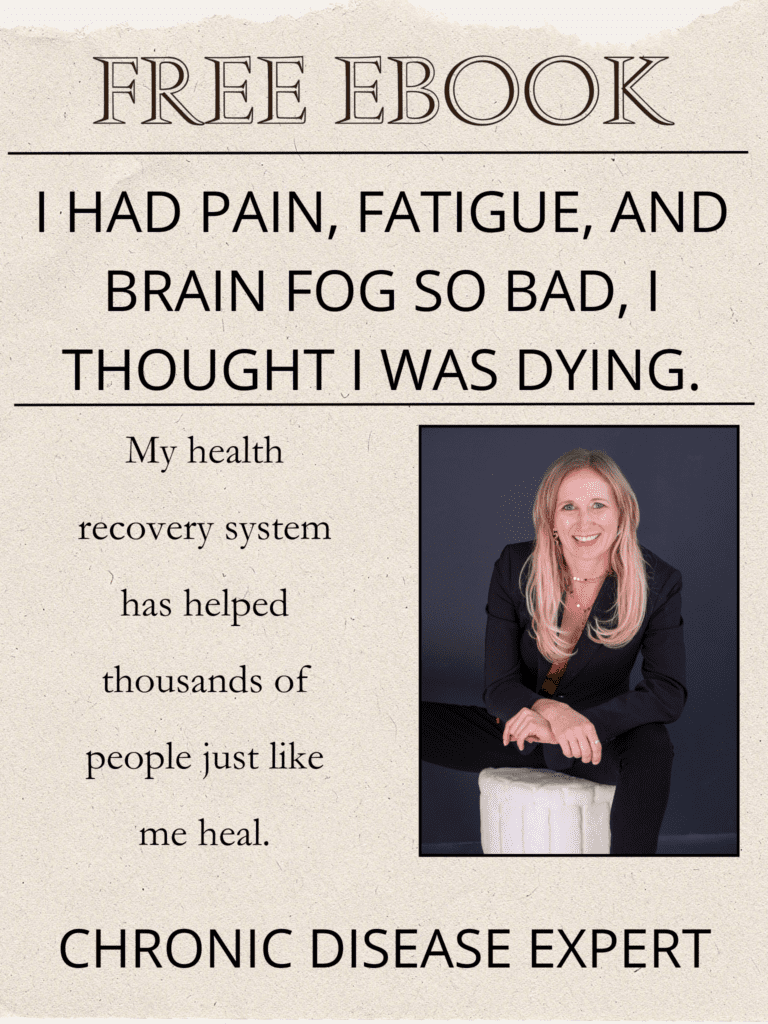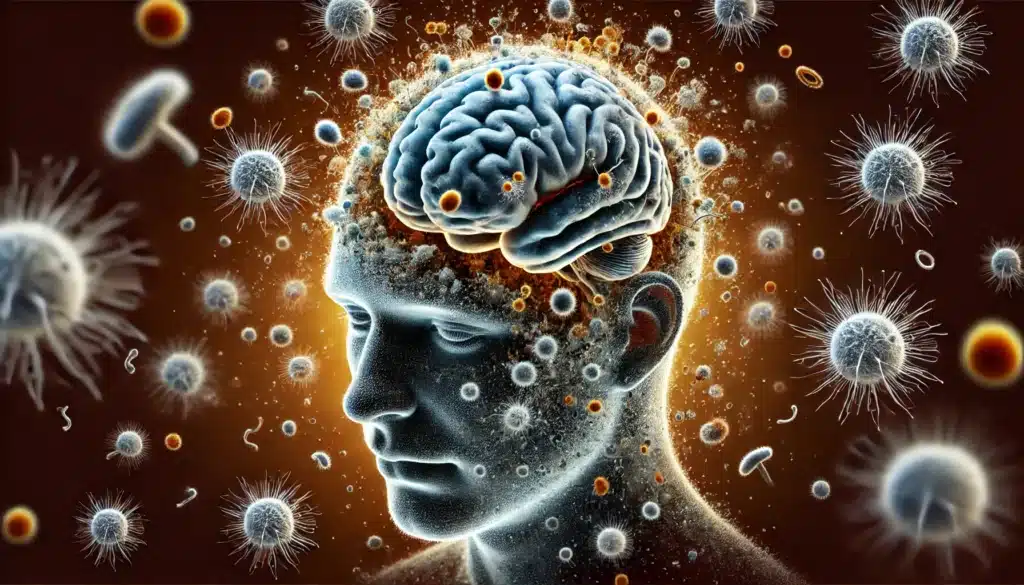
Written by Dr. Diane Mueller
Ever wondered why your brain feels like it’s swimming in molasses? You might be surprised to learn that the culprit could be lurking in your walls. Yep, we’re talking about mold – that pesky fungus that’s more than just an eyesore. It can mess with your head, literally. In this article, we’re gonna dive into neurological symptoms of mold exposure.
So, if you’ve been scratching your head about that musty smell in your basement and those killer headaches, stick around. We’re about to blow the lid off the hidden dangers in your home that’s affecting your head.

Have Lyme Disease or suspect you do?
Mold hides in damp corners, behind walls, and under carpets. But unlike your annoying cousin, mold can do some real damage to your health, especially your brain.
When it comes to brain-busting molds, a few nasties top the list:
Remember, any mold can be bad news for your health
Alright, let’s get into the nitty-gritty of how mold messes with your mind.
Mold exposure can turn your brain into a battlefield. Here’s what might go down:
In some nasty cases, long-term mold exposure has been linked to more serious brain issues like Alzheimer’s, Parkinson’s, and even ALS. Scary stuff.
Alzheimer’s and Other Dementias: Research suggests mold toxins may accelerate cognitive decline and potentially contribute to the development of dementia-like symptoms.
Parkinson’s Disease: Some studies indicate that mold exposure could potentially trigger symptoms similar to those seen in Parkinson’s disease, affecting motor control and coordination.
Amyotrophic Lateral Sclerosis (ALS): While the connection is not definitively proven, there is ongoing research into the potential role of mold exposure in ALS development.
Multiple Sclerosis (MS): Mold may impact the immune system in ways that could potentially lead to MS-like symptoms, though more research is needed in this area.
Dizziness, Vertigo, and Postural Orthostatic Tachycardia (POTS): Mold exposure can cause balance issues and dizzy spells, potentially related to its effects on the nervous system.
Convulsions: In severe cases of mold toxicity, muscle spasms and convulsions have been reported.
Seizures: There is evidence suggesting that mold exposure could potentially trigger seizure activity in some individuals.
Cognitive Impairment (“Brain Fog”): Many individuals report difficulty concentrating and general cognitive impairment after mold exposure.
Ataxia: Loss of muscle control and coordination can occur, potentially due to mold’s impact on the nervous system.
It’s important to note that while these associations exist, individual responses to mold exposure vary person to person. If you suspect mold-related health issues, don’t play WebMD roulette, just get a real mold doc to check you out for a proper evaluation and treatment.
Mold doesn’t just mess with your thinking – it can turn your emotions into a hot mess too. Some folks exposed to black mold have experienced seizures (talk about a party pooper). Others find themselves on an emotional seesaw, swinging between feeling fine and feeling like the world’s ending.
And let’s not forget about POTS (Postural Orthostatic Tachycardia Syndrome) – a condition that can make you feel like you’re gonna pass out every time you stand up. Some unlucky folks have developed this after tangling with black mold.
Different molds pack different punches. Let’s break down these fungal fiends and their nasty tricks:
You can see that many of these different mycotoxins can cause cellular death of the nerves. The death and dysfunction of nerves will lead to the variety of diseases mentioned above. Unfortunately, it is all too common that people are diagnosed with neurological diseases (sometimes terminal) and are not given this very helpful information. Check out our blog called Test for Black Mold in order to read about how test properly for mold illness. Many times, doctors just run mold allergy tests, which are improper for looking for the accumulation of toxins that cause these neurological diseases.
How does mold affect your brain:
When mold toxins get into your bloodstream, they’re like tiny invaders storming the castle of your brain. They mess with your neurotransmitters – the brain’s messaging system – causing all sorts of chaos. It’s like someone cutting the wires in your brain’s communication network.
For example, citrinin likes to pick on your hippocampus – the part of your brain that handles memory and learning. Meanwhile, trichothecenes mess with your brain cells’ power plants (mitochondria), leaving them running on fumes.
Mold toxins don’t just disrupt; they also cause inflammation in your nervous system. It’s like your brain’s on fire, and not in a good way. This inflammation can lead to a bunch of neurological symptoms and even damage your brain cells over time.
Scientists have found higher levels of inflammatory markers like Interleukin-6 and Tumor Necrosis Factor-alpha in people exposed to mold. It’s like your brain’s sending out SOS signals, saying, “Hey, we’re under attack here!”
This constant state of inflammation and toxicity can, over time, pave the way for some serious brain conditions. It’s like mold is slowly remodeling your brain, and not for the better.
Alright, enough doom and gloom. While there are Natural Treatment Options if you suspect you have mold be sure to BOOK A CALL to go over how to kick mold to the curb and get your brain back on track
Prevention is key when it comes to mold. Here’s some quick tips to keep the your you home – here are some quick tips:
Preventive Measure
Preventive Measure | Application |
Regular check-ups for mold growth | In living spaces, especially damp areas |
Use of dehumidifiers | Managing moisture and preventing mold growth |
Proper ventilation | Maintaining mold-free environments |
Exhaust fans and air purifiers with HEPA filters | Remove mold spores from the air |
By combining these treatments and prevention tactics, you can give mold the boot and keep your brain firing on all cylinders.
For more information on Mold Exposure, see our other blog:
We’ve taken a wild ride through the moldy maze of brain symptoms. From feeling foggy to mood swings that’d make a teenager blush, we’ve seen how these sneaky spores can really mess with your head. We’ve also peeked into mold’s toxic toolbox and how it turns your brain into a battlefield.
And always remember to be an advocate for yourself. The medical community is really just beginning to understand these diseases and there is a lot of inaccurate information out there. Working with a Mold & Lyme Literate Doctor is essential for your proper diagnosis and recovery.
[1] Agahi
F, Juan C, Font G, Juan-García A. Neurotoxicity of zearalenone’s metabolites and beauvericin mycotoxins via apoptosis and cell cycle disruption. Toxicology. 2021 May 30;456:152784. doi: 10.1016/j.tox.2021.152784. Epub 2021 Apr 16. PMID: 33872728.
Malekinejad H, Aghazadeh-Attari J, Rezabakhsh A, Sattari M, Ghasemsoltani-Momtaz B.Neurotoxicity of mycotoxins produced in vitro by Penicillium roqueforti isolated from maize and grass silage. Hum Exp Toxicol. 2015 Oct;34(10):997-1005. doi: 10.1177/0960327114565493. Epub 2015 Mar 5. PMID: 25743727.
Lipopolysaccharide-induced blood-brain barrier disruption:roles of cyclooxygenase, oxidative stress, neuroinflammation, and elements of the neurovascular unit. J Neuroinflammation. 2015 Nov 25;12:223. doi: 10.1186/s12974-015-0434-1. PMID: 26608623; PMCID: PMC4660627.
[1] Arce-López B, Alvarez Erviti L, De Santis B, Izco M, López-Calvo S, Marzo-Sola ME, Debegnach F, Lizarraga E, López de Cerain A, González Peñas E, Vettorazzi A. Biomonitoring of Mycotoxins in Plasma of Patients with Alzheimer’s and Parkinson’s Disease. Toxins (Basel). 2021 Jul 10;13(7):477. doi: 10.3390/toxins13070477. PMID: 34357949; PMCID: PMC8310068.
Park S, Lee JY, You S, Song G, Lim W. Neurotoxic effects of aflatoxin B1 on human astrocytes in vitro and on glial cell development in zebrafish in vivo. J Hazard Mater. 2020 Mar 15;386:121639. doi: 10.1016/j.jhazmat.2019.12163 . Epub 2019 Nov 21. PMID: 31787402.
[1] Mateo E, Tonino RPB, Canto A, Monroy Noyola A, Miranda M, Soria JM, Garcia Esparza MA. The Neurotoxic Effect of Ochratoxin-A on the Hippocampal Neurogenic Niche of Adult Mouse Brain. Toxins (Basel). 2022 Sep 6;14(9):624. doi: 10.3390/toxins14090624. PMID: 36136561; PMCID: PMC9501519.
Free Lyme/Mold Webinar: "Why Am I Still Sick?"
Have Lyme Disease or suspect that you do?
We have helped thousands of
people restore their health
and quality of life by diagnosing
and treating their Lyme Disease.
“Dr. Mueller’s approach to medicine is refreshing! There is only so much you can do with western medicine and in my life I was needing a new approach. By addressing the whole body, nutritional diet factors, environmental factors, blood work, and incorporating ideas I had not previously known, I was able to break through with my conditions. I am not only experiencing less pain in my life, but through the process of healing guided by Dr. Diane Mueller, I am now happy to say I have more consciousness surrounding how I eat, what to eat and when things are appropriate. Living by example Dr. Mueller has a vibrancy that makes you want to learn and know more about your body and overall health. I highly recommend her to anyone looking for new answers, a new approach to health, or in need of freedom from pain and limitations.”
-Storie S.
Kihei, HI
Lyme Disease is Often Misdiagnosed as Fibromyalgia, Chronic Fatigue, Depression,
or Other Illnesses
Have Lyme Disease or suspect you do?
